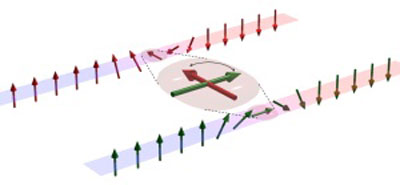| May 09, 2011 |
Spintronics: Hitting the wall
|
|
(Nanowerk News) The storage of data on magnetic media like hard disk drives is accomplished by orienting minute magnetic domains using magnetic fields. Although a mature technology, this approach requires relatively bulky components and complex control schemes. An alternative is to use an electrical method, where a spin-polarized electrical current is applied to rearrange magnetic domains directly using what is known as the 'spin torque' effect. However, some aspects of this approach remain unconfirmed, such as whether there is any intrinsic resistance to the manipulation of magnetic domain walls, even in a perfect nanowire.
|
|
Teruo Ono and colleagues from Kyoto University and NEC in Japan have now obtained experimental evidence of intrinsic domain wall pinning in a ferromagnetic nanowire through observations of the minimum current required to shift domain walls ("Observation of the intrinsic pinning of a magnetic domain wall in a ferromagnetic nanowire").
|
 |
| A domain wall in a ferromagnetic wire occurs at the boundary between spin domains with different orientations (red/blue). A spin-polarized current (center) can reorient and move that boundary. (© 2011 NPG)
|
|
A domain wall can be held in place by a variety of external factors, including roughness, defects or designed constrictions and notches in the ferromagnet. These factors have been found to dominate the threshold currents required to move domain walls in ferromagnetic nanowires. Intrinsic effects that result in the pinning of domain walls have also been predicted, but have not been observed.
|
|
In their search for evidence of intrinsic pinning, Ono and his colleagues applied a series of short current pulses to cobalt–nickel nanowires and then detected the movement of domain walls.
|
|
The research team found two independent pieces of evidence that current-driven magnetic domain switching in cobalt–nickel nanowires is not limited solely by extrinsic factors. First, the threshold current necessary to move domain walls down the nanowires was found to be smallest for nanowires with a width at which the energies of the domain wall configurations before and after the current pulses are equal, indicating an absence of extrinsic factors. Second, they observed that the threshold current was independent of the strength of an externally applied magnetic field, which would affect extrinsic but not intrinsic domain wall pinning.
|
|
This experimental verification of intrinsic domain wall pinning (see image) will contribute to the development of robust, low-energy memories and other technologies based on the spin torque effect.
|

